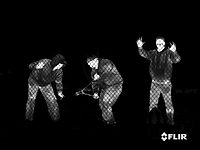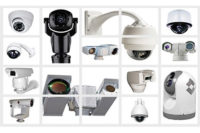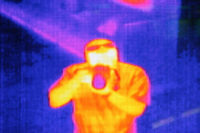Heat, Light and Detection: The Future of Thermal Cameras

Two trends are coming together and spreading to enterprise applications as thermal cameras attach to unmanned aerial vehicles or drones.
Photos courtesy of DJI Innovations and Flir Systems

The thermal camera bottom line, says Kevin McNamara of G4S Secure Integration, “is accurate detection, clarity and quality of image.”
Photo courtesy of G4S Secure Integration


The thermal camera bottom line is accurate detection, clarity and quality of image.
Benjamin Franklin has thermal cameras. General Douglas McArthur pioneered their use. In Jay Weatherill’s hands, thermal cameras can fight a killer from a safe distance.
But, unlike their traditional surveillance siblings, thermal sensors and cameras create video images from infrared – heat waves. Day or night, in any environment, every person, object and structure emits infrared waves. And, while traditional cameras often flex their CCD chip muscles with after-incident forensics, the strength of thermals, especially at night, is more often seen at facility perimeters and often aims at real-time detection and physical response.
Thermals follow through on a time-tested strategy of detect, delay and respond, institutionalized at facilities such as nuclear power plants and elsewhere.
First applied in the early 1950s by U.S. and Republic of Korea troops against the Soviet-backed Democratic People’s Republic of Korea, military and law enforcement were user pioneers of the technology. Originally big, bulky, short range and very expensive while needing similarly expensive accessories, thermal cameras have evolved into today’s small contained packages boasting longer ranges at more affordable prices.
Covers More Ground
And speaking of long range, a single smart thermal camera can detect intruders with great accuracy over an area the size of a football field, combining detection and visual verification deployed either as a standalone solution or integrated.
So it is not surprising that applications have spread from military to critical infrastructure, petrochemical, power distribution, port/border, commercial and life safety, among others.
When it comes to certain critical infrastructure, for example, a large petrochemical plant, without thermals the assignment would be daunting, with some campuses having a perimeter of 10 miles or more. In another instance, areas of waterfront or wetlands may not allow use of more typical physical barriers and enhancements – fences and lighting, to name two.
Comparable to virtual fences created by traditional cameras, thanks to levels of analytics, in the thermal world, there are thermal fences that don’t require physical barriers, lighting infrastructure or extended power trenches. Also seen: integration with ground radar and more seamlessness of routine fence sensors and alarms.
Thermals protect sensitive unban facilities, too. For instance, thermal video analytics cameras from SightLogix cover the World Trade Center outdoor perimeter in New York City. The cameras are an integral part of an integrated security system designed by engineers from Ducibella, Venter & Santore and integrated by Diebold.
Fire, Life Safety Uses
Australian Prime Minister Jay Weatherill proudly acknowledges long-range thermal cameras in tracking down hot spots and flying sparks during that country’s effort to tamp out recent, destructive bush fires. Another unique application, the cameras, carefully positioned in airport corridors, determined whether a passenger had a high temperature while attempting to fly out of a country impacted by the Ebola epidemic. Often behavior monitoring doubled down to identify passengers that looked ill. Today, thermals are even more common at airports as part of traditional surveillance systems although thermals are not designed to read a person’s specific body temperature but can be finely calibrated to discern slight differences.
And Ben Franklin?
Mobility and flexibility are among the advantages of thermals for Benjamin Franklin, the largest container ship to ever make port in North America just late last year. It’s longer than the Empire State building is high and has cameras that look out to sea, setting up an ever-moving, all-seeing perimeter to help captain and crew alert to objects moving toward the megaship. Thermals also are common on ships plying waters from Sumatra to Somalia as they try to get a perimeter alert advantage over pirates, who are after cargo, payroll cash and even kidnapping ransom money.
Just months ago, there was another commercial-centric breakthrough as highlighted by a collaboration between thermal camera maker Flir Systems, of Goleta, California, and unmanned aerial vehicle – drone – maker DJI Innovations of Los Angeles. They plan to develop a stabilized camera featuring Flir’s thermal imaging technology for some DJI’s aerial platforms.
The addition of thermal imaging to drones, only in commercial infancy, provides the ability to see in complete darkness, measure temperature remotely and see through obscurants such as smoke, dust and light fog. Integration with a live video downlink system and apps will also give drone operators in enterprise and government security departments with real-time control and recording during flight.
Concerning the commercial niche of camera-equipped and security-facing drones, state and local regulations are just now falling into place. The Federal Aviation Administration (FAA) contends it is in charge of manned and unmanned aircraft, including hobbyist gear. In late 2015, the agency issued new recreational drone rules, requiring users to register in a national database, among other rules.
Drone with Camera Regulations Vary
Such a stance, however, has set up potential clashes since local and state lawmakers, worried about safety and privacy, have been passing similar and differing rules. More than 20 states approved drone laws in 2015, as have cities including Chicago, Los Angeles and Miami.
For enterprises seeing value in adding camera-enabled drones to their collection of security solutions, getting from here to there – faster, more accurate detection, more use of the unmanned aerial vehicles for patrolling and surveillance – is obviously adding technology and complexity to seeing from above in the dark or near dark. Today, current advances have led to smaller cameras that are more affordable, says Jay McNamara, senior project manager for G4S Secure Integration, with accurate detection, clarity and quality of image. He observes that analytics creates smart thermal solutions, image processing within the camera can virtually eliminate false alarms, all often happening at the edge. When it comes to effectiveness, he says to “look for technology that provides digital detail enhancements,” adding some key features are “scene optimization and active contrast enhancement,” among others.
There are numerous features and benefits, especially linked to smart thermal cameras.
When it comes to temperature gauging, thermal temperature alarm cameras easily cross over to operations and business uses, too. Such cameras can send an alarm when the temperature reaches above or below a pre-configured threshold. With thermal imaging, problem areas can be identified before the issue becomes visible to the eye or machinery stops working. They also provide data for thermal pattern analysis or are useful for detection in perimeter protection or by law enforcement to identify thermal spots in vehicles.
More with Smart Thermal Cameras
Specific to smart thermal solutions and analytics, depending on the camera maker, some thermals also have speed measurement. One example is models from ATN American Technologies Network, which fashions a camera to act like a speed radar with functions that allow you to receive alerts/set alarms whenever objects within it go over a certain speed. There are thermal cameras to help track objects and people within it. Tracked is the path of objects such as cars as well as people within it, and, in addition, track anything dropped by people within it, known as dropped objects detection. Loitering detection follows when an object has extended its welcome within a given area, as well as determines how long objects have been within an area.
Other thermal camera features in some units:
- Electronic stabilization to correct for pole sway;
- Geo-registration to ignore small animals, blowing trash and outdoor movement while detecting people all the time;
- Geospatial detection zones based on target size, speed and direction;
- With its low power needs, available are solar and wireless options; and
- Targets can be projected onto a sitemap for real-time situational awareness.
Additionally, thermals are easier to install nowadays, with less fuss in the set-up and maintenance.
When it comes to real-time alarming, according to McNamara, thermal cameras can detect accurately in complete darkness as well as bright sun and harsh environmental conditions. The cameras can be unaffected by headlights, reflections or other stray lights that cause nuisance alerts for visible detection cameras.
No doubt, there are myriad thermal, night vision and infrared cameras as well as some traditional cameras with supplementary illumination from lights or lasers as part of the category. Choices depend, among many, on light availability, security goals, budget and – in the case of whatever it is called – product marketing.
Lens Size Counts
While some end users may assume that distance can be a challenge, in reality, thermal cameras can provide accurate detection based on what lens size is used; but at greater distances, the ability to provide assessment of a human-sized target at a higher detail becomes challenging at greater distances, says McNamara. Of course, day/night cameras are still used and popular, he says.
When it comes to wide dynamic range (WDR) cameras as compared to thermals when facing lighting challenges, there is sometimes confusion. WDR is not just for daytime but also can be used at night for some applications such as nighttime license plate recognition. Thermals are not just for night but can be used in daylight. For instance, in glare, thermal will detect someone entering a glared-over area.
There are color night vision cameras that use advanced low light sensors to provide high quality color video in lighting conditions from full daylight to starlight, all without extra lighting infrastructure needed with regular security cameras. Such a tech approach detects intruders with thermal and identifies them with color night vision.
Thermal Imaging plus On-Board Analytics
How Thermal Cameras Work
It’s heat without the magic.
Thermal sensors and cameras create video images from infrared – heat waves. Infrared is a part of the electromagnetic spectrum with wavelengths that are longer than visible light. Infrared is typically divided into near, mid, long and extreme and measured in units known as microns.
The warmer an object, the more energy it emits.
Infrared energy emitted by a viewed scene is focused through the specialized objective lens assembly of a thermal camera on to the camera’s focal plane array, which uses materials that respond by generating electrical impulses when infrared energy strikes it. These electrical impulses are then sent in the form of temperature values to an image signal processor that turns them into video data for presentation on a display.
Two types of thermal technology are available, each with its own advantages. For some devices, there are “uncooled” sensors, built with a detector that allows for a very small camera size, low weight, minimal power requirements and high resolution. “Cooled” systems employ technology that uses a highly efficient cryogenic cooler that enables the detector to sense smaller differences in infrared emissions. Cooled technology, often aimed at security uses, can capture images at a greater distance, produce a higher resolution image and operate with smaller optics.
An image intensifier or image intensifier tube is a vacuum tube device for increasing the intensity of available light in an optical system to allow use under low light conditions, such as at night, to facilitate visual imaging of low light processes.
Information provided by DRS Technologies.
Thermal Imaging plus On-Board Analytics
Here is a benefits checklist covering most types of thermal cameras with analytics:
- Good, useable image both day and night and in adverse conditions;
- Reliability of the analytics, as well as visual assessment capabilities of the operator receiving the alarm;
- No lighting required;
- Customers may be able to turn site lighting off or minimize it;
- Low power and bandwidth consumption;
- Low maintenance and cost of ownership;
- Lower false alarm rate; and
- Classification-based alarms (human, vehicle, as one example).
Information provided by Matt Bretoi, vice president, North America field sales, security and surveillance for Flir Systems.
Looking for a reprint of this article?
From high-res PDFs to custom plaques, order your copy today!








